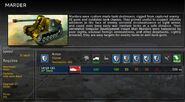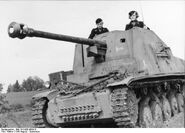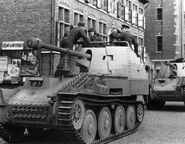Using a 7.5 cm PaK 40 mounted on the outdated Panzer II chassis, the Marder II (Marder is German for Marten, a kind of weasel) proved to be an excellent stop-gap vehicle to combat enemy armor, although it was fazed out of service by later tank destroyer models such as the Hetzer, the Jagdpanzer IV, the Jagdpanther, and the Nashorn.
For a vehicle that was often hampered by unfamiliar ammunition types, inadequate sights, and thin armor, it acquitted itself well on the battlefield. The Marder is at its best in the 1942 era, as a group of these versatile little vehicles can go toe-to-toe with most enemy medium tanks of that time. It lacks infantry weapons for self-defense, and is vulnerable to air attack, but this is balanced by a quick rate of production and only a $15 price tag.
History[]
Even in the early stages of Fall Barbarossa, the Wehrmacht already felt the need for a more mobile and more powerful anti-tank solution than the existing towed anti-tank guns such as PaK 36 or tank destroyers like the Panzerjäger I. This need became urgent in June 1941, when anti-tank shells failed to penetrate the armor of new Soviet tanks like the T-34 and KV-1.
As an interim solution, it was decided to use captured French vehicles like the Lorraine, obsolete tanks such as German Panzer II, and Czech-supplied 38(t) as the base for makeshift tank destroyers. The result was the Marder series, which were armed with either captured Soviet 76.2mm F-22 Model 1936 divisional field guns, or 75mm PaK 40 anti-tank guns for later versions. Due to weight and space constraints of these small chassis, Marder series were not fully armored. Weak armor protection was provided only for the front and sides. All Marder series had open tops, although some were issued with canvas tops to protect the crew from the elements. This proved to be hazardous, as an enemy could simply toss a Molotov cocktail or hand grenade inside and render the crew combat ineffective.
Strategies and Tactics[]
- The Marder II is best used in the 1942 era.
- When in groups of 2 or 3 and accompanied by a few Panzer IV tanks, the enemy's land forces will have to strain in order to counter your attack.
- The Marder II is good for attacking the enemy head-on, although enemy fighter-bombers (especially the A.I. players) will target it first. Air cover is needed.
- With its fast production time and decent speed, the Marder II can be used as a 'fireman' of sorts, rushing from your anti-tank base to the enemy tanks that are attacking.
Pros & Cons[]
+It has the 500m range rather than 400m and dps matching
+Somewhat high speed.
-Poor armor
Weapons[]
| Weapon | ||||||||||
|---|---|---|---|---|---|---|---|---|---|---|
Large cal. AP shell |
400 | 100 | 50 | 25 | 20 | 12 | 500m |
Gallery[]
See also[]
| ||||||||||||||||||||||||||



